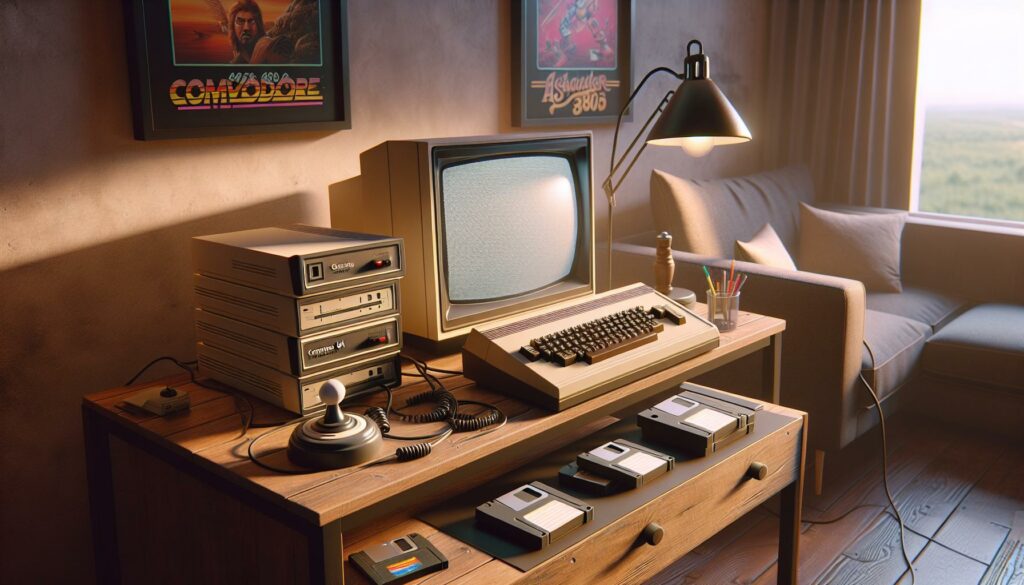I can’t help feeling nostalgic when I think about those massive beige boxes that introduced many of us to the digital world. Old school computers from the 1980s and 1990s may seem primitive by today’s standards but they laid the groundwork for our modern computing experience.
From the iconic Apple II to the revolutionary Commodore 64 these machines weren’t just tools – they were gateways to endless possibilities. I remember the distinctive sound of floppy disk drives whirring to life and the satisfying click of mechanical keyboards. While they may have had less processing power than today’s smartphones these vintage computers taught us patience perseverance and problem-solving skills that remain valuable even now.
Key Takeaways
- The 1980s marked the golden age of personal computing, with iconic machines like the Commodore 64 (17M units sold) and Apple II (6M units) leading the revolution
- Old school computers, despite limited processing power, introduced fundamental computing concepts and programming skills through BASIC language and MS-DOS commands
- Early personal computers transformed education through software like Oregon Trail, Number Munchers, and Carmen Sandiego, establishing technology’s role in learning
- Business productivity software such as WordPerfect, Lotus 1-2-3, and WordStar revolutionized office workflows and document creation in the 1980s
- Gaming on vintage computers pioneered both arcade ports and text-based adventures, with companies like Infocom selling over 4 million copies of their interactive stories
- Preserving these historic machines requires careful maintenance, including proper cleaning, component replacement, and storage in controlled environments
Old School Computers
The 1980s marked a transformative era in computer history with affordable home computers entering millions of households. This period revolutionized how people interacted with technology through pioneering machines that defined personal computing.
Commodore 64 and Its Impact
The Commodore 64 dominated the personal computing landscape from 1982 to 1994, selling over 17 million units worldwide. Its MOS Technology 6510 microprocessor operated at 1 MHz with 64 kilobytes of RAM, establishing new standards for home computing capabilities. The C64’s SID sound chip produced distinctive three-voice synthesized sound, enabling revolutionary gaming experiences through titles like:
- Summer Games
- Impossible Mission
- Elite
- Zak McKracken
I’ve witnessed how the C64’s BASIC programming language introduced countless users to coding fundamentals, creating a generation of tech enthusiasts. The machine’s affordable $595 price point made computing accessible to middle-class families.
The Apple II Revolution
The Apple II series transformed education technology between 1977 and 1993 with over 6 million units sold. Its open architecture design included:
- 8 expansion slots for hardware customization
- Color graphics capabilities supporting 6 colors
- Built-in BASIC programming language
- 48K RAM in early models
I recall how the Apple II’s presence in schools established Apple’s educational market dominance through software like:
| Educational Software | Release Year | Impact Area |
|---|---|---|
| Oregon Trail | 1985 | History |
| Number Munchers | 1986 | Mathematics |
| Bank Street Writer | 1982 | Writing |
| Carmen Sandiego | 1985 | Geography |
The machine’s ProDOS operating system provided a sophisticated file management structure, introducing students to modern computing concepts.
Early IBM PC and Compatible Systems
The IBM Personal Computer revolutionized business computing after its release in 1981, establishing industry standards that shaped modern PCs. The open architecture design sparked a competitive market of IBM PC compatibles, leading to widespread adoption in offices worldwide.
MS-DOS Era
MS-DOS transformed the computer industry by providing a standardized command-line interface across IBM PCs and compatibles. Here’s what made MS-DOS significant:
- Command syntax relied on specific text inputs like DIR to list files, CD to change directories, COPY for file duplication
- Batch files automated repetitive tasks through sequential command execution
- Memory management maxed at 640KB conventional memory in early versions
- File naming followed the 8.3 format (8 characters filename + 3 character extension)
- Third-party tools enhanced functionality with menu interfaces, file managers, disk optimizers
Popular Software of the 1980s
Business productivity software dominated the IBM PC ecosystem during the 1980s:
| Software | Release Year | Key Features |
|---|---|---|
| WordPerfect 5.1 | 1989 | Reveal codes, macro recording, mail merge |
| Lotus 1-2-3 | 1983 | Integrated spreadsheet, graphics, database |
| dBase III | 1984 | Relational database, programming language |
| Norton Utilities | 1982 | Disk recovery, file management tools |
| Microsoft Flight Simulator | 1982 | Wire-frame graphics, realistic controls |
- WordStar introduced professional word processing with embedded formatting commands
- VisiCalc sparked widespread business adoption of personal computers
- AutoCAD revolutionized computer-aided design in engineering fields
- Print Shop enabled custom banner, card, sign creation
- King’s Quest pioneered graphic adventure gaming with animated characters
Gaming on Vintage Computers
Vintage computers transformed gaming with their unique capabilities and limitations, creating experiences that defined early digital entertainment.
Classic Arcade Ports
Early home computers brought arcade favorites directly into living rooms through innovative ports. The Commodore 64 excelled with authentic conversions of games like Pac-Man, Donkey Kong and Space Invaders. These ports featured modified graphics and sound to accommodate hardware constraints while maintaining core gameplay mechanics. Popular arcade-to-computer translations included:
- Defender (1983) for Atari 8-bit computers with redesigned controls for keyboard input
- Dragon’s Lair (1984) for Apple II using compressed animations on multiple floppy disks
- Galaga (1984) for IBM PC featuring CGA graphics in 4-color mode
- Ms. Pac-Man (1984) for Commodore 64 with advanced sprite capabilities
- Double Dragon (1988) optimized for 8-bit system limitations
Text-Based Adventures
Text adventures pioneered interactive storytelling through typed commands and vivid descriptions. Infocom dominated this genre with titles selling over 4 million copies between 1979-1989. Notable text adventures included:
- Zork I (1980) featuring the Great Underground Empire setting
- Hitchhiker’s Guide to the Galaxy (1984) based on Douglas Adams’ work
- Trinity (1986) exploring atomic age themes through puzzle-solving
- A Mind Forever Voyaging (1985) incorporating social commentary
- Planetfall (1983) combining science fiction with humor
| Command Type | Examples |
|---|---|
| Movement | GO NORTH, CLIMB TREE |
| Actions | TAKE LAMP, DROP SWORD |
| Investigation | EXAMINE WALL, LOOK UNDER BED |
| Interaction | TALK TO GUARD, GIVE COIN |
| Inventory | INVENTORY, GET ALL |
The Rise of Home Computing
Home computers transformed daily life in the 1980s by bringing digital technology into living rooms across America. These machines introduced millions to computing through affordable hardware bundled with practical software applications.
Educational Software
Educational software emerged as a cornerstone of home computing in the early 1980s. The Oregon Trail led this revolution, teaching history through interactive gameplay while selling over 65 million copies. MECC (Minnesota Educational Computing Consortium) developed numerous educational titles including:
- Number Munchers for mathematics practice
- Word Munchers for vocabulary building
- Odell Lake for ecosystem understanding
- Rocky’s Boots for logic learning
Early Word Processing
Word processing software revolutionized document creation by replacing typewriters with digital text manipulation. Notable programs included:
- WordStar (1978): Featured cursor-based editing with ctrl-key commands
- Bank Street Writer (1982): Offered simplified interface for home users
- AppleWriter (1979): Provided split-screen editing on Apple II computers
- HomeWord (1984): Introduced WYSIWYG display with graphical icons
| Software | Release Year | Peak Market Share | Notable Feature |
|---|---|---|---|
| WordStar | 1978 | 40% | Mail merge |
| Bank Street Writer | 1982 | 25% | Kid-friendly interface |
| AppleWriter | 1979 | 30% | ProDOS compatibility |
| HomeWord | 1984 | 15% | Icon-based menus |
Each program introduced unique features that simplified text creation for home users while establishing standards for modern word processors.
Collecting and Preserving Old School Computers
Preserving vintage computers requires specialized knowledge of electronics repair technical expertise. The process involves both finding authentic systems and maintaining their functionality for future generations.
Restoration Tips
I’ve identified five essential steps for restoring vintage computers:
- Clean circuit boards with 99% isopropyl alcohol to remove corrosion deposits
- Replace capacitors showing signs of leakage or bulging
- Test power supplies with a multimeter to verify correct voltage outputs
- Lubricate mechanical components like disk drives with appropriate synthetic oils
- Document all repairs with photos detailed notes for future reference
Storage conditions affect preservation:
- Maintain temperature between 65-75°F
- Keep humidity levels at 45-55%
- Store systems away from direct sunlight
- Use anti-static bags for component protection
- Place silica gel packets inside storage containers
Where to Find Vintage Systems
Key sources for acquiring old school computers include:
Physical Locations:
- Estate sales with documented computer history
- Local computer repair shops
- Electronics recycling centers
- University surplus auctions
- Ham radio swap meets
Online Marketplaces:
- eBay’s Vintage Computing section
- Reddit’s r/retrobattlestations
- Vintage Computer Forums marketplace
- Local Facebook Marketplace listings
- Specialized collector websites
| System Condition | Average Price Range |
|---|---|
| Non-working | $50-200 |
| Working | $200-800 |
| Complete in Box | $800-2500 |
| Rare Models | $2500+ |
Role in Shaping Today’s Digital Landscape
Looking back at these vintage computers I can’t help but feel grateful for their role in shaping today’s digital landscape. They weren’t just machines – they were gateways to innovation that laid the foundation for modern computing.
The legacy of these pioneering systems lives on through collectors enthusiasts and preservationists who keep their stories alive. Whether you’re a tech history buff or simply curious about computing’s roots these old school computers remind us how far we’ve come and inspire us to imagine where technology will take us next.
I believe there’s something truly special about these early computers that modern devices just can’t replicate – a charm that continues to captivate generations of technology enthusiasts.

